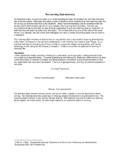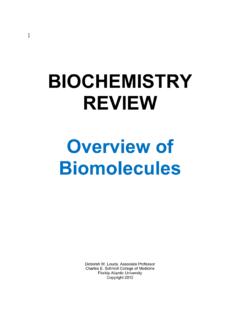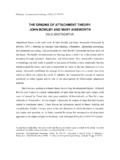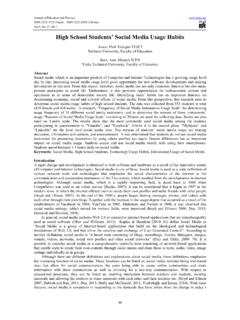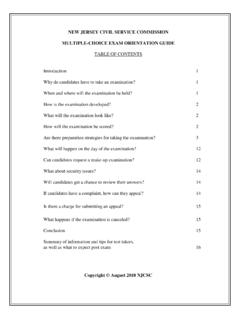Transcription of Questions with Answers- Proteins & Enzymes
1 Questions with answers - Proteins & Enzymes A. A peptide with 12 amino acids has the following amino acid composition: 2 Met, 1 Tyr, 1 Trp, 2 Glu, 1 Lys, 1 Arg, 1 Thr, 1 Asn, 1 Ile, 1 Cys Reaction of the intact peptide with fluorodinitrobenzene followed by acid hydrolysis creates a derivative of Ile. A specific cleavage of the intact peptide produces fragments with the following sequences: Glu-Cys-Asn-Met-Lys Met-Glu-Thr-Arg-Trp Ile-Tyr ( Questions 1-5) Which reagent was used for the specific cleavage?
2 A) chymotrypsin b) trypsin c) V8 protease d) cyanogen bromide Which amino acids would be released when the intact peptide was treated first with V8 protease followed by treatment with cyanogen bromide? a) Glu and Met b) Glu and Lys c) Met and Lys d) Glu, Met, and Lys Which treatment would result in the release of Lys and Arg from the intact peptide? a) trypsin b) trypsin followed by dansyl chloride c) trypsin followed by carboxypeptidase d) trypsin followed by mild acid If this intact peptide is sequenced using the Edman degradation, which step will be part of the procedure?
3 A) The Edman reagent will react with all 12 amino acids simultaneously. b) Lithium borohydride will react with an -carboxyl group. c) Phenylisothiocyanate will react with an -amino group. d) Strong acid will be used to cleave off one modified amino acid. If this peptide is normally part of a multimeric protein composed of four identical subunits, what procedure might be needed prior to performing the Edman degradation? a) The four subunits should be separated and sequenced individually. b) Two specific cleavages should be done to create two sets of fragments.
4 C) Peptide bonds should be broken using hydrazine. d) Disulfide bonds should be reduced with mercaptoethanol. _____ B. A peptide has the following amino acid composition: 2 Met, 2 Phe, 2 Glu, 1 Arg, 1 Lys, 1 Val, 1 Leu, 1 Gly, 1 Ser Reaction of the intact peptide with dansyl chloride followed by acid hydrolysis creates a derivative of Met. A specific cleavage of the intact peptide produces fragments with the following sequences: Fragment A: Glu-Gly-Lys-Phe Fragment B: Met-Ser-Leu-Arg Fragment C: Met-Val-Glu-Phe ( Questions 6-10) Which reagent was used for the specific cleavage?
5 A) cyanogen bromide b) V8 protease c) chymotrypsin d) trypsin Which reagent would break only one peptide bond in the intact peptide? a) cyanogen bromide b) V8 protease c) chymotrypsin d) trypsin Which amino acid would be released if the intact peptide was treated with a combination of trypsin and chymotrypsin? a) Lys b) Phe c) Glu d) Met What information do these result give about the sequence of the peptide?
6 A) The sequence is: Met-Val-Glu-Phe-Glu-Gly-Lys-Phe-Met-Ser- Leu-Arg b) The sequence is: Met-Ser-Leu-Arg-Met-Val-Glu-Phe-Glu-Gly- Lys-Phe c) The sequence is: Met-Val-Glu-Phe-Met-Ser-Leu-Arg-Glu-Gly- Lys-Phe d) The sequence is: Met-Ser-Leu-Arg-Glu-Gly-Lys-Phe-Met Val-Glu-Phe This peptide is one polypeptide chain of a multimeric protein that contains two non-identical subunits. What problem might be seen when analyzing the primary structure of the protein if the subunits were not separated?
7 A) Fluorodinitrobenzene might react with two different amino acids. b) Carboxypeptidase might not react with the C-terminals. c) Mercaptoethanol might not reduce disulfide bonds. d) Lithium borohydride might cleave peptide bonds randomly. _____ C. protein A is an -keratin while protein B is a transport protein . ( Questions 11-15) Which characteristic could be shared by protein A and protein B? a) Both could be fibrous Proteins containing multiple polypeptide chains. b) Both could be globular Proteins with similar primary structures.
8 C) Both could contain disulfide bridges linking methionine residues. d) Both could contain hydrogen bonds between peptide bond atoms. When comparing protein A to a -keratin a) the -keratin has a parallel structure while the -keratin has an antiparallel structure. b) the -keratin has a compact structure while the -keratin has a more extended structure. c) both have similar secondary structures that are low-energy states for the Proteins .
9 D) both contain hydroxyproline which functions as a prosthetic group. When comparing protein B to collagen, a) both are stabilized by van der Waals interactions . b) both are stabilized by extensive regions of left-handed coils. c) both contain regions of random secondary structures. d) both contain -helices as well as -pleated sheets. Which interaction is likely to occur in protein B? a) A hydrophobic interaction could form between the R-groups of Val and Leu. b) A hydrogen bond could form between the R-groups of Ser and Phe.
10 C) A salt bridge could form between the R-groups of Arg and His. d) An ionic bond could form between the R-groups of Gln and Trp. When comparing protein A to protein B, a) both could be denatured by using heat to break amide bonds. b) both could have primary structures that form with the help of chaperones. c) both have conformations stabilized by numerous non-covalent bonds. d) both contain the same proportions of hydrophilic and hydrophobic R- groups.
